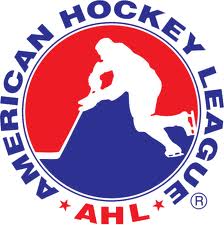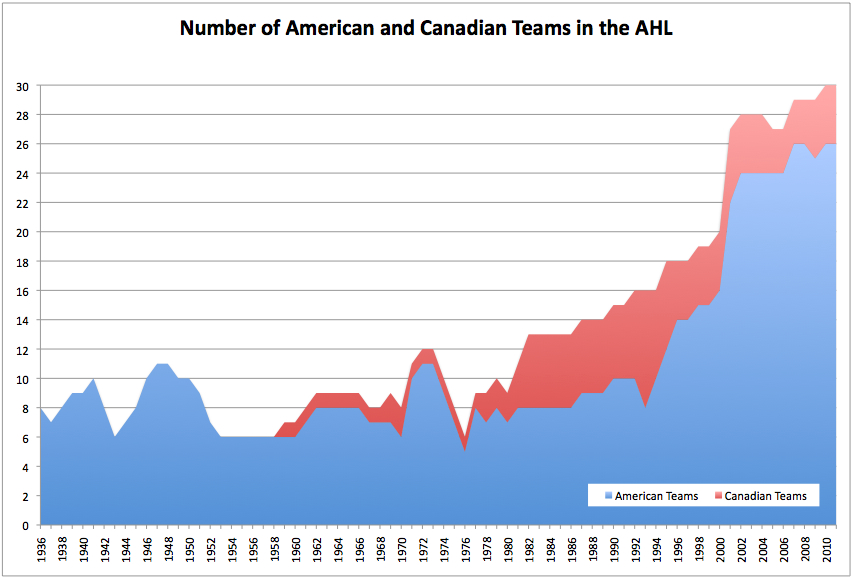
Considering that the American Hockey League has firmly established itself as the primary development league of the NHL, and knowing how rabid passionate Canadians are about hockey, what does the AHL – a league that’s very name ostensibly excludes Canada – mean to Canadians?
The re-birth of the Winnipeg Jets showed that a new Canadian entry to the NHL is cause for celebration north of the 49th parallel. National leaders made speeches, t-shirts were printed, season tickets were sold out within minutes of being made available, and icebergs were decorated in festive colors.
The resulting trickle-down return of AHL hockey to St. John’s Newfoundland was greeted with less fanfare, but also with exuberance and brisk ticket sales.
Sounds good, so far.
But a closer look is warranted, starting with how much Canada is in the AHL, anyway?
The American(adian) Hockey League?
The AHL has a venerable history that stretches back to 1936 when the Canadian-American Hockey League and the International Hockey League agreed to play an inter-organization schedule; that arrangement became permanent by the fall of 1938 and the leagues merged. Despite their names, neither of these leagues contained anything but American franchises when they began to mingle.
It took more than 20 years for the first Canadian-based franchise to enter the AHL, when the Quebec Aces (of Jean Beliveau fame) skated as part of the 1959-60 campaign.
In 1993, fully half of the AHL’s 16 teams were located north of the border, but that total had shrunk to three by 2005.
Today, four of the 30 AHL franchises are located in Canada – but the number of Canadian franchises has fluctuated, as has their percentage of the league total.

The Canadian footprint was widest in 1993, when fully half of the AHL’s 16 teams were located north of the border, but had shrunk to back to three by 2005.
Broadly speaking, Canadian teams have been the icing on the AHL’s cake, with Canadian franchises representing a smaller share of the league than in the NHL.
Attendance
Though few, one might think that Canadian AHL teams would realize benefits at the gate due to their host nation’s adoration of all things hockey.
Yet this is not universally the case.
In the 2011-12 season, the St. John’s IceCaps has the highest attendance among the Canadian teams, with an average of 6 287 fans taking in each game. Meaning that the ‘Caps filled the home floe to max capacity for every game – good enough for the ninth highest average attendance in the 30-team league. If more Newfoundlanders could have been packed into the Mile One Centre, then the fledgling team would have moved up the attendance charts.
The St. John’s IceCaps had the ninth highest AHL average attendance in 2011-12, while the Toronto Marlies, Hamilton Bulldogs, and Abbortford Heat ranked 14th, 21st, and 29th respectively.
The other Canadian teams didn’t fare as well, however. The Toronto Marlies ranked 14th, the Hamilton Bulldogs 21st, and the Abbotsford Heat came in at 29th, with a paltry average of 3 545 fans taking in their home games. None of these three teams averages approached capacity for their buildings.
The season previous, the Manitoba Moose ranked 2nd in average attendance, while Toronto, Hamilton, and Abbotsford each ranked 17th, 21st, and 26th respectively.
The limp support in the Golden Horseshoe region of Ontario, which contains Toronto and Hamilton, is especially perplexing to some, not just because of the millions of potential fans, but also because this was the same population base that was largely responsible for drowning the gray city of Buffalo in Team Canada-red during the 2011 World Junior Championship.
Looking ahead to the 2012-13 season, it will be interesting to see if the Marlies can capitalize on their Calder-Cup run that did generate excitement and ticket sales. Both Calder Cup Finals matches in Toronto were sold out.
The AHL’s Personalities
There is no question that a strong majority of players in the AHL, even recently, have been Canadian. There is a healthy minority of Americans, along with a smattering of Europeans to round out the league’s demographics.
Check out the parade of Calder-Cup-in-Canada photos as the (now former Admirals) players take their turn with the Cup on Twitter at @CalderCup.
Perhaps indicating the depth of Canadian hockey, the AHL has a higher percentage of Canadian-born players than the more cosmopolitan NHL (Canadians still represent more than half of today’s NHLers).
Although the exact demographics are notoriously slippery, consider that the AHL’s All-Star format pitted a team Canada against variously-named versions of an ‘everybody else’ team between 1997 and 2010.
Further, 22 of 36 roster players (61%) from the Stanley Cup winning Los Angeles Kings were Canadian, while 20 of 27 players (74%) of the Calder Cup-hoisting Norfolk Admirals hailed from north of the longest undefended border.
Check out the parade of Calder-Cup-in-Canada photos as the (now former Admirals) players take their turn with the Cup on Twitter at @CalderCup.
Beyond the players, many General Managers, coaches and other staff are certainly Canadian – much like the NHL – and the AHL’s heralded President and CEO since 1994, David Andrews was born in Canada.
Sum up already – It’s July and there’s beer sun to enjoy!
The bottom line: It’s not exactly the ‘Eh’HL and it never has been (editor’s note: Ron MacLean called – he wants his ban pun back), so don’t hold your breath for a “Make it Five” AHL campaign in Canada.
It’s naive to think that Canadians embrace everything hockey – they simply don’t have the time, and the AHL has tough competition in Canada.
Selling hockey in Canada is akin to selling ice in the Arctic – the people are surrounded by it, so it had better be outstanding ice. The task is particularly unforgiving in big markets like Toronto where the competition for entertainment dollars is fierce.
Perhaps that explains why stand-out AHL events like the Outdoor Classic in Hamilton attracted more than 20 000 fans, and why the Marlies’ successful playoff translated into a 27% increase in average attendance over their regular season numbers – springtime hockey has become a novelty in Toronto.
Were good-natured barbs throw during the recently concluded AHL marketing meetings held in Rochester, New York, with non-traditional hockey market staff mistakenly suggesting that the Canadian franchises have it easy somehow?
Impossible to know, but any lines were probably dropped by the new guys. The veterans have long ago realized that the AHL can take nothing for granted – especially in Canada.
I’m not one to stand in the middle of good geography debate, but to answer Ms. Komes question the point of the article was to take a look at the relationship between Canada and the AHL.
And, while everyone is entitled to their opinion, I suspect most folks in North America would equate the term “America” with the United States of America. For example, I don’t think you’d see Canadians, Mexicans, or Argentinians (because let’s not exclude our South American neighbors) visiting other countries and introducing themselves as “American”.
BKL
Canada is still in North AMERICA correct?
good point let’s rename it the NAHL…haha.
Stephen, that would make things a little confusing. Have two CHLs is bad enough. ;)
Yes, and so is Mexico, what’s your point?
exactly, what’s the point of the article.